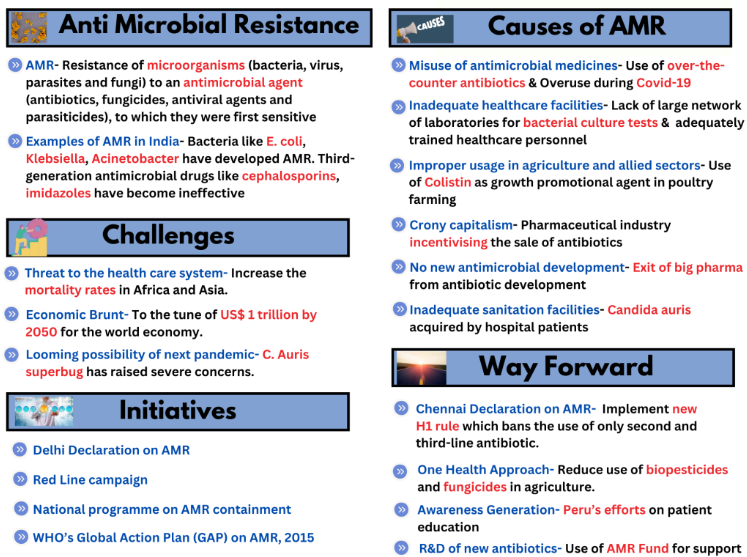23 October 2024 : Indian Express Editorial Analysis
1. MEDICINE USE AND MISUSE
(Source: Indian Express; Section: The Editorial Page; Page: 10)
| Topic: GS3 – Science & Technology |
| Context: |
| The article discusses the UN General Assembly’s recognition of antimicrobial resistance (AMR) as a global health threat and the urgent need for coordinated action through the One Health approach to combat its widespread impacts. |

The Global Health Threat of Antimicrobial Resistance (AMR)
- The UN General Assembly (UNGA) officially recognized antimicrobial resistance (AMR) as a critical “global health threat and developmental challenge.”
- AMR endangers human, animal, and plant health, underscoring its importance not just for health but also for equitable economic growth and a healthy environment.
- The Assembly’s high-level meeting demanded immediate action, advocating for the One Health approach—a concept that addresses the interconnectedness of human, animal, and environmental health.
Understanding Antimicrobials and Their Misuse
- Antimicrobials encompass a wide range of drugs, including antibiotics, antivirals, antifungals, and antiparasitics, used in humans, animals, and plants.
- Since the 1950s, these drugs have been widely overused, not only to treat diseases but also as “growth promoters” in industrial-scale food production.
- In 2000, the World Health Organization (WHO) recommended phasing out the use of antibiotics as growth promoters in agriculture, citing their contribution to the rise of AMR.
- The misuse of antimicrobials can reverse gains made in combating infectious diseases and complicate treatments for illnesses like tuberculosis and malaria, making surgeries and cancer treatments more hazardous and expensive.
The Impact of AMR on Global Health and Economy
- AMR disproportionately affects low- and middle-income countries, where poverty and inequality exacerbate the drivers and consequences of the resistance.
- According to the World Bank, AMR could lead to additional healthcare costs of up to $1 trillion by 2050, with global GDP losses estimated at $1 to $3.4 trillion annually by 2030.
- These economic consequences are comparable to the financial toll of the 2008 global financial crisis, potentially widening the inequality between nations.
Global Targets and National Action Plans
- The UNGA’s political declaration set clear goals to reduce the estimated 4.95 million annual deaths associated with bacterial AMR by 10 percent by 2030.
- To achieve this, the declaration advocates sustainable national financing and $100 million in catalytic funding to ensure that at least 60 percent of countries implement funded national action plans on AMR by 2030.
- Other critical targets include ensuring that 70 percent of antimicrobials used in human healthcare belong to the WHO Access Group (which has minimal side effects and lower potential to cause AMR) and that all countries have basic water, sanitation, and hygiene (WASH) facilities in healthcare settings.
Addressing the Environmental Dimensions of AMR
- The environmental aspects of AMR include the need to prevent the discharge of antimicrobials into the environment. This involves more research and action to address key sources of antimicrobial pollution.
- The One Health approach, which links human, animal, and environmental health, is crucial for tackling AMR.
- To be successful, collaborations across these sectors must be backed by political commitment, policies, sustainable financing, and civil society engagement.
India’s Commitment to Combating AMR
- India reaffirmed its commitment to fighting AMR during the UNGA meeting. The updated National Action Plan for AMR 2.0 emphasizes inter-sectoral collaboration with robust monitoring mechanisms.
- India’s National One Health Mission, a cross-ministerial initiative, aims to strengthen surveillance programs and laboratory capabilities, addressing gaps in the fight against AMR.
- The UN’s mandate provides an opportunity for India to refine and reshape its AMR strategies to align with global efforts.
| What Should Be The Way Ahead in Reducing AMR? |
|
AMR is a complex socio-economic and political challenge and not just a scientific issue to be solved by doctors and researchers alone. 1. Improvement of Sanitation and Hygiene– The sanitation in hospitals and basic access to personal hygiene must be improved to reduce the spread of AMR. 2. Implementation of the Chennai Declaration on AMR– The new H1 rule which banned the use of only second and third-line antibiotic must be implemented at the earliest to prevent the over-the-counter sales of antibiotics. 3. Investment in Public Health infrastructure– The investment in public health infrastructure like network of laboratories, hospitals, recruitment of trained medical professionals must be enhanced at the earliest. For ex- NCCD reports points out that states with good public health systems have lower AMR. 4. Improving governance and monitoring framework– Environmental governance, planning and regulatory frameworks must be enhanced to combat the menace of AMR. For ex- Involve the Ministry of environment to stop the contamination of antimicrobials. 5. One Health Approach– Any actions on AMR must be guided by the ‘One Health Approach’- a holistic approach that links the health of humans with our shared environment. This will help in reducing the use of biopesticides and fungicides in agriculture. 6. Robust investment in R&D of new antibiotics– Funding support must be taken from the AMR Action Fund for the development of new and power antibiotics. 7. Awareness Generation on AMR– Peru’s efforts on patient education to reduce unnecessary antibiotic prescriptions must be used as a learning point. |
| PYQ: Can overuse and the availability of antibiotics without doctor’s prescription, the contributors to the emergence of drug-resistant diseases in India? What are the available mechanisms for monitoring and control? Critically discuss the various issues involved. (200 words/12.5m) (UPSC CSE (M) GS-3 2014) |
| Practice Question: Antimicrobial resistance (AMR) has been recognized as a critical global health threat with significant economic and developmental implications. Discuss the role of the One Health approach in combating AMR and how can India strengthen its efforts in this regard? (250 words/15 m) |

